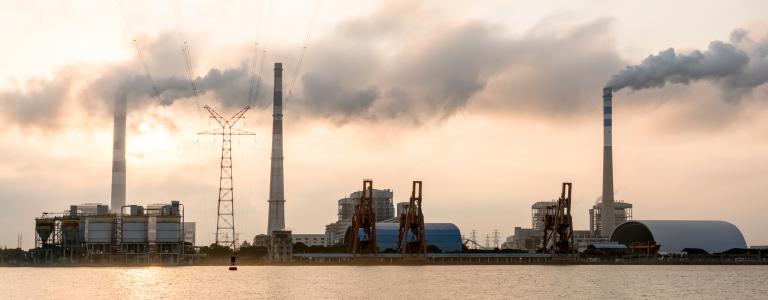Reactions to Canada's Climate Change Framework: Industry
In the third of a series of blog posts on the Pan-Canadian Framework on Clean Growth and Climate Change, Amin Asadollahi explores what the framework will mean for industry.
In December 2016, Canada's First Ministers released their Pan-Canadian Framework on Clean Growth and Climate Change. In this series of blog posts we break down the Framework, explaining what is proposed, what the strengths are and what challenges may lie ahead.
In this post, we focus on industry.
WHAT IS THE ISSUE?
In 2014, about two fifths of Canada’s greenhouse gas (GHG) emissions came from industrial sectors.
More than half of industrial emissions are from oil and gas production, processing and distribution—the fastest-growing source of Canada’s GHG emissions. Alberta’s cap on oil sands emissions will ensure, for the first time, that the sector’s emissions will not go unchecked, but does still provide room for growth, including for projects currently under construction. The emissions cap—combined with performance requirements and a price on carbon—could decrease the GHG intensity of the oil sands. As a result, oil sands production volumes could increase over time without an increase in upstream emissions beyond the cap. This growth raises the need to reduce emissions from other sectors of the economy. It will also be imperative to reinvest revenues generated from the oil and gas sector to support the transition to a clean energy future.
The oil and gas sectors are also responsible for about 40 per cent of emissions of methane, a short-lived climate pollutant whose global warming potential is 86 times higher than that of carbon dioxide. Methane, however, is a short-lived climate pollutant with a life of 12 years versus carbon dioxide, which stays in the atmosphere for thousands of years. In other words, by phasing out short-lived climate pollutants, we will see immediate benefits and can increase the chances of staying within climate-safe limits. Canada agreed to phase out hydrofluorocarbons (HFCs), another short-lived climate pollutant, which is expected to result in the avoidance of 0.5℃ in temperature increase.
HOW DOES THE PAN-CANADIAN FRAMEWORK PLAN TO ADDRESS THE PROBLEM?
The Framework provides three solutions to reduce emissions in the industrial sector:
- Reducing methane and HFCs
- Implementing energy efficiency measures
- Investing in research and the development of clean technologies.
WHAT ARE THE STRENGTHS OF THE PROPOSED SOLUTIONS?
On October 14, 2016, Canada was part of a historic international agreement to phase out HFCs, the single biggest climate commitment ever. Reducing methane by 40 to 45 per cent by 2025 is a step in the right direction on another short-lived climate pollutant. Recognition of the need to invest in energy efficiency across the industrial sector is a similarly positive move. Addressing energy waste is often one of the lowest-cost emission reduction opportunities.
For the industrial sector to reduce its emissions, innovation will be key, and governments can be strategic partners. Continued investment in new technologies and support for pre-commercial demonstration projects should send a strong positive signal to industry on the government’s commitment.
WHAT ARE SOME KEY ELEMENTS TO CONSIDER IN IMPLEMENTING A ROBUST POLICY?
The phase-out of methane can result in near-immediate climate benefits and turn the temperature down in the short term. The Framework, however, does not provide a path towards this objective. Although reducing methane in the oil and gas sector by about half is a good first step, it falls short of what is needed to meet climate objectives, especially where additional emission reduction opportunities may exist. A plan to phase out methane emissions to the extent technologies permit, beyond 2025 and across all sectors, will be needed.
In relation to oil and gas emissions, one way to reduce intentional methane venting is to flare, which is a better alternative but also a wasteful practice. In addition, flaring can result in the production of black carbon, a climate pollutant that can accelerate the melting of sea ice. Canada has agreed to eliminate routine flaring by 2030 and to reduce black carbon emissions. In reducing methane from the oil and gas sector, governments should prioritize conservation and ensure that regulations do not result in increased flaring and black carbon emissions.
You might also be interested in
IISD Welcomes Draft Regulations for Oil and Gas Pollution Cap
A firm cap on emissions can provide certainty for industry to invest in decarbonization, while ensuring the sector is on a path to net-zero by 2050.
Canadians on the Hook for up to CAD 18.8 Billion in Ongoing Subsidies to the Trans Mountain Pipeline
Canadian taxpayers could end up contributing up to CAD 18.8 billion in subsidies to the Trans Mountain Pipeline if the federal government continues charging discounted transportation tolls to the oil industry, according to a new IISD report.
For Nature-Based Solutions to Be Effective, We Need to Work with Indigenous Peoples and Local Communities
Nature-based solutions have been praised as a promising approach to tackling the twin crises of climate change and biodiversity loss. But some Indigenous Peoples and local communities are questioning the legitimacy of the concept and what it symbolizes. It is time to listen to what they have to say.
Global Dialogue on Border Carbon Adjustments
This report contributes to the global BCA discussion by summarizing country-level reports reflecting dialogues conducted in Brazil, Canada, Trinidad and Tobago, the United Kingdom, and Vietnam.
